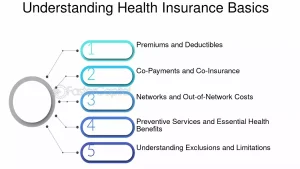Navigating the complexities of health insurance can be daunting, especially when it comes to understanding the financial components that significantly affect your healthcare costs. Key terms like premiums, deductibles, and copayments are fundamental to grasping how your health insurance plan works. This article will break down these concepts, their roles in health insurance, and how they impact your overall healthcare expenses.
 What is a Health Insurance Premium?
What is a Health Insurance Premium?
A premium is the amount you pay for your health insurance policy, typically billed monthly. This fee is necessary to maintain your coverage and ensure that you have access to healthcare services when needed. Premiums can vary widely depending on several factors:
- Type of Plan: Different types of health insurance plans (e.g., HMOs, PPOs, EPOs) have different premium structures.
- Coverage Level: Plans that offer more comprehensive coverage usually come with higher premiums.
- Age and Location: Generally, older individuals may pay higher premiums, and costs can vary based on geographic location.
- Tobacco Use: Many insurers charge higher premiums for tobacco users, reflecting the increased health risks associated with smoking.
Why Premiums Matter
Understanding your premium is essential because it represents a fixed cost that must be budgeted for every month. Even if you don’t use healthcare services frequently, you must pay this amount to maintain your insurance coverage.
What is a Deductible?
A deductible is the amount you must pay out-of-pocket for covered healthcare services before your insurance starts to contribute. For example, if your plan has a deductible of $1,500, you will need to pay that amount for medical expenses before your insurance begins to cover the costs.
Types of Deductibles
- Individual Deductible: The amount one person must pay before the insurance coverage kicks in.
- Family Deductible: The total amount that the entire family must pay before insurance starts covering costs for all family members. Family deductibles often have a limit that is higher than individual deductibles but can provide a cap on family expenses.
Importance of Understanding Deductibles
Deductibles play a crucial role in determining how much you will spend on healthcare throughout the year. Plans with lower deductibles typically have higher premiums, while those with higher deductibles may offer lower premiums. When selecting a plan, consider your healthcare needs:
- Regular Users: If you frequently require medical services or ongoing treatment, a plan with a lower deductible may be more cost-effective in the long run.
- Occasional Users: If you rarely seek medical care, a higher deductible plan with a lower premium might be a better choice, but be prepared for potentially higher out-of-pocket costs in case of unexpected health issues.
What is a Copayment?
A copayment (or copay) is a fixed amount you pay for specific healthcare services at the time of your visit. For example, you might pay a copay of $20 for a primary care visit or $10 for a prescription medication. Copayments can vary based on the type of service and whether the provider is in-network or out-of-network.
Copayment Examples
- Primary Care Visit: $20
- Specialist Visit: $40
- Emergency Room Visit: $150
- Prescription Medication: $10 to $50, depending on the medication tier
Why Copayments Matter
Copayments provide a manageable way to budget for healthcare expenses. Since they are fixed amounts, you know upfront what you will pay for certain services, making it easier to plan your healthcare budget. They also encourage individuals to seek necessary medical care without the burden of high out-of-pocket costs.
How Premiums, Deductibles, and Copayments Work Together
Understanding how premiums, deductibles, and copayments interact is essential for comprehending your overall healthcare costs. Here’s how they fit together:
- Paying Your Premium: Regardless of your healthcare usage, you must pay your premium every month to maintain your coverage.
- Meeting Your Deductible: When you receive care, you will first pay out-of-pocket until you meet your deductible. After reaching this threshold, your insurance will begin to cover a portion of your costs.
- Using Copayments: Even after meeting your deductible, you may still be responsible for copayments for certain services. For instance, if you see a doctor after reaching your deductible, you might pay a copayment for that visit.
Example Scenario
To illustrate how these components work together, consider the following example:
- You have a health insurance plan with a monthly premium of $300, a deductible of $1,500, and a copayment of $20 for office visits.
- In a given year, you visit your primary care physician four times and have some lab tests that total $500.
Costs Breakdown:
- Premiums: You pay $3,600 in premiums ($300 x 12 months).
- Deductible: You pay $1,500 out-of-pocket to meet your deductible.
- Copayments: You pay $80 for the four doctor visits ($20 x 4).
- Total Costs: Your total healthcare costs for the year would be $5,180 ($3,600 premiums + $1,500 deductible + $80 copayments).
 Conclusion
Conclusion
Understanding health insurance premiums, deductibles, and copayments is essential for making informed decisions about your healthcare coverage. Each component plays a distinct role in determining your overall healthcare costs and can significantly impact your financial well-being.
When selecting a health insurance plan, carefully evaluate your healthcare needs, budget, and the specific details of each plan. By understanding how these elements work together, you can choose a plan that best fits your lifestyle and financial situation, ensuring that you receive the care you need without unexpected financial burden. Educating yourself about these key terms will empower you to navigate the health insurance landscape with confidence.


